Koorosh Aslansefat
Mapping the Mind of an Instruction-based Image Editing using SMILE
Dec 20, 2024Abstract:Despite recent advancements in Instruct-based Image Editing models for generating high-quality images, they are known as black boxes and a significant barrier to transparency and user trust. To solve this issue, we introduce SMILE (Statistical Model-agnostic Interpretability with Local Explanations), a novel model-agnostic for localized interpretability that provides a visual heatmap to clarify the textual elements' influence on image-generating models. We applied our method to various Instruction-based Image Editing models like Pix2Pix, Image2Image-turbo and Diffusers-Inpaint and showed how our model can improve interpretability and reliability. Also, we use stability, accuracy, fidelity, and consistency metrics to evaluate our method. These findings indicate the exciting potential of model-agnostic interpretability for reliability and trustworthiness in critical applications such as healthcare and autonomous driving while encouraging additional investigation into the significance of interpretability in enhancing dependable image editing models.
Explainability of Point Cloud Neural Networks Using SMILE: Statistical Model-Agnostic Interpretability with Local Explanations
Oct 20, 2024Abstract:In today's world, the significance of explainable AI (XAI) is growing in robotics and point cloud applications, as the lack of transparency in decision-making can pose considerable safety risks, particularly in autonomous systems. As these technologies are integrated into real-world environments, ensuring that model decisions are interpretable and trustworthy is vital for operational reliability and safety assurance. This study explores the implementation of SMILE, a novel explainability method originally designed for deep neural networks, on point cloud-based models. SMILE builds on LIME by incorporating Empirical Cumulative Distribution Function (ECDF) statistical distances, offering enhanced robustness and interpretability, particularly when the Anderson-Darling distance is used. The approach demonstrates superior performance in terms of fidelity loss, R2 scores, and robustness across various kernel widths, perturbation numbers, and clustering configurations. Moreover, this study introduces a stability analysis for point cloud data using the Jaccard index, establishing a new benchmark and baseline for model stability in this field. The study further identifies dataset biases in the classification of the 'person' category, emphasizing the necessity for more comprehensive datasets in safety-critical applications like autonomous driving and robotics. The results underscore the potential of advanced explainability models and highlight areas for future research, including the application of alternative surrogate models and explainability techniques in point cloud data.
SafeLLM: Domain-Specific Safety Monitoring for Large Language Models: A Case Study of Offshore Wind Maintenance
Oct 06, 2024



Abstract:The Offshore Wind (OSW) industry is experiencing significant expansion, resulting in increased Operations \& Maintenance (O\&M) costs. Intelligent alarm systems offer the prospect of swift detection of component failures and process anomalies, enabling timely and precise interventions that could yield reductions in resource expenditure, as well as scheduled and unscheduled downtime. This paper introduces an innovative approach to tackle this challenge by capitalising on Large Language Models (LLMs). We present a specialised conversational agent that incorporates statistical techniques to calculate distances between sentences for the detection and filtering of hallucinations and unsafe output. This potentially enables improved interpretation of alarm sequences and the generation of safer repair action recommendations by the agent. Preliminary findings are presented with the approach applied to ChatGPT-4 generated test sentences. The limitation of using ChatGPT-4 and the potential for enhancement of this agent through re-training with specialised OSW datasets are discussed.
Scope Compliance Uncertainty Estimate
Dec 17, 2023Abstract:The zeitgeist of the digital era has been dominated by an expanding integration of Artificial Intelligence~(AI) in a plethora of applications across various domains. With this expansion, however, questions of the safety and reliability of these methods come have become more relevant than ever. Consequently, a run-time ML model safety system has been developed to ensure the model's operation within the intended context, especially in applications whose environments are greatly variable such as Autonomous Vehicles~(AVs). SafeML is a model-agnostic approach for performing such monitoring, using distance measures based on statistical testing of the training and operational datasets; comparing them to a predetermined threshold, returning a binary value whether the model should be trusted in the context of the observed data or be deemed unreliable. Although a systematic framework exists for this approach, its performance is hindered by: (1) a dependency on a number of design parameters that directly affect the selection of a safety threshold and therefore likely affect its robustness, (2) an inherent assumption of certain distributions for the training and operational sets, as well as (3) a high computational complexity for relatively large sets. This work addresses these limitations by changing the binary decision to a continuous metric. Furthermore, all data distribution assumptions are made obsolete by implementing non-parametric approaches, and the computational speed increased by introducing a new distance measure based on the Empirical Characteristics Functions~(ECF).
Explaining black boxes with a SMILE: Statistical Model-agnostic Interpretability with Local Explanations
Nov 13, 2023Abstract:Machine learning is currently undergoing an explosion in capability, popularity, and sophistication. However, one of the major barriers to widespread acceptance of machine learning (ML) is trustworthiness: most ML models operate as black boxes, their inner workings opaque and mysterious, and it can be difficult to trust their conclusions without understanding how those conclusions are reached. Explainability is therefore a key aspect of improving trustworthiness: the ability to better understand, interpret, and anticipate the behaviour of ML models. To this end, we propose SMILE, a new method that builds on previous approaches by making use of statistical distance measures to improve explainability while remaining applicable to a wide range of input data domains.
Online Dynamic Reliability Evaluation of Wind Turbines based on Drone-assisted Monitoring
Nov 23, 2022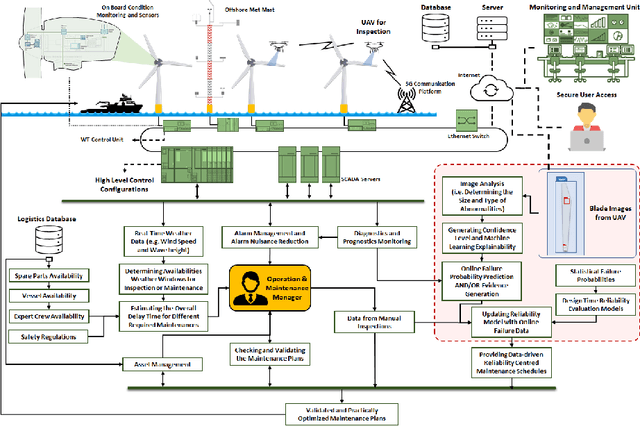
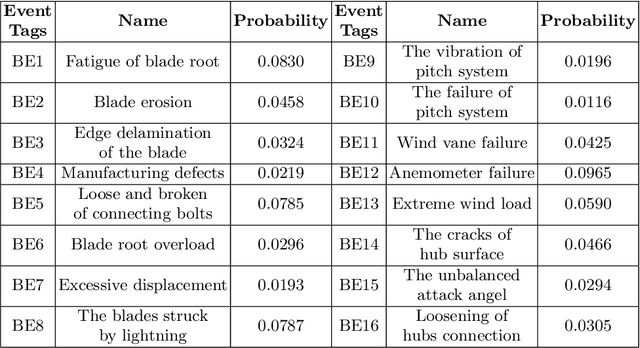


Abstract:The offshore wind energy is increasingly becoming an attractive source of energy due to having lower environmental impact. Effective operation and maintenance that ensures the maximum availability of the energy generation process using offshore facilities and minimal production cost are two key factors to improve the competitiveness of this energy source over other traditional sources of energy. Condition monitoring systems are widely used for health management of offshore wind farms to have improved operation and maintenance. Reliability of the wind farms are increasingly being evaluated to aid in the maintenance process and thereby to improve the availability of the farms. However, much of the reliability analysis is performed offline based on statistical data. In this article, we propose a drone-assisted monitoring based method for online reliability evaluation of wind turbines. A blade system of a wind turbine is used as an illustrative example to demonstrate the proposed approach.
A Deep Learning Framework for Wind Turbine Repair Action Prediction Using Alarm Sequences and Long Short Term Memory Algorithms
Jul 19, 2022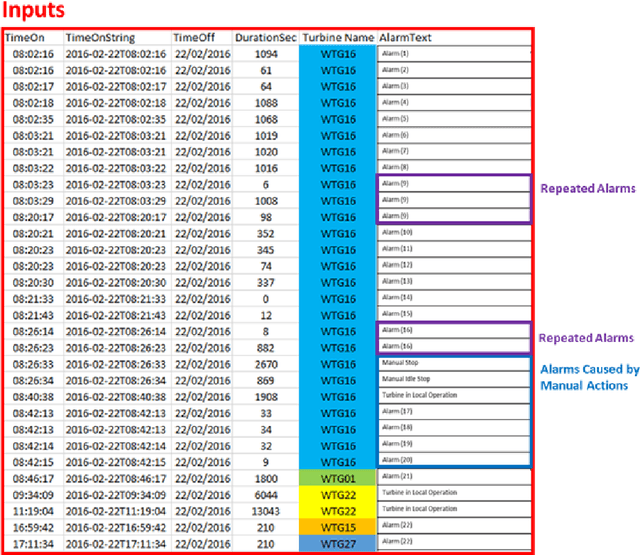



Abstract:With an increasing emphasis on driving down the costs of Operations and Maintenance (O$\&$M) in the Offshore Wind (OSW) sector, comes the requirement to explore new methodology and applications of Deep Learning (DL) to the domain. Condition-based monitoring (CBM) has been at the forefront of recent research developing alarm-based systems and data-driven decision making. This paper provides a brief insight into the research being conducted in this area, with a specific focus on alarm sequence modelling and the associated challenges faced in its implementation. The paper proposes a novel idea to predict a set of relevant repair actions from an input sequence of alarm sequences, comparing Long Short-term Memory (LSTM) and Bidirectional LSTM (biLSTM) models. Achieving training accuracy results of up to 80.23$\%$, and test accuracy results of up to 76.01$\%$ with biLSTM gives a strong indication to the potential benefits of the proposed approach that can be furthered in future research. The paper introduces a framework that integrates the proposed approach into O$\&$M procedures and discusses the potential benefits which include the reduction of a confusing plethora of alarms, as well as unnecessary vessel transfers to the turbines for fault diagnosis and correction.
SafeDrones: Real-Time Reliability Evaluation of UAVs using Executable Digital Dependable Identities
Jul 12, 2022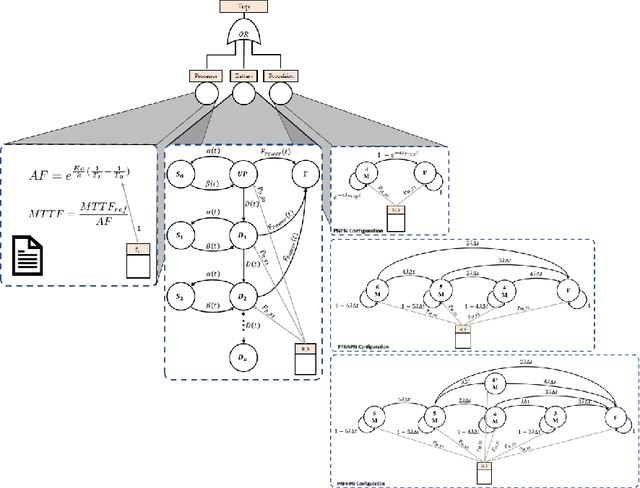
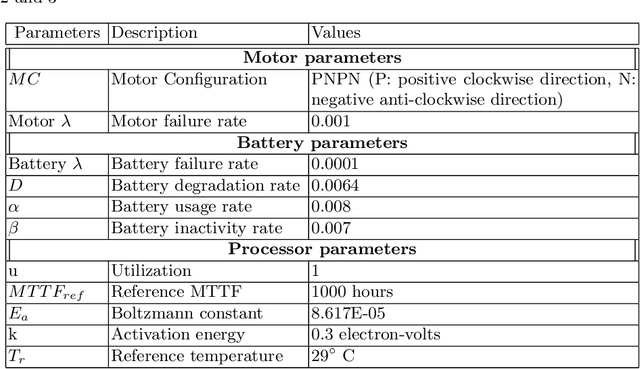
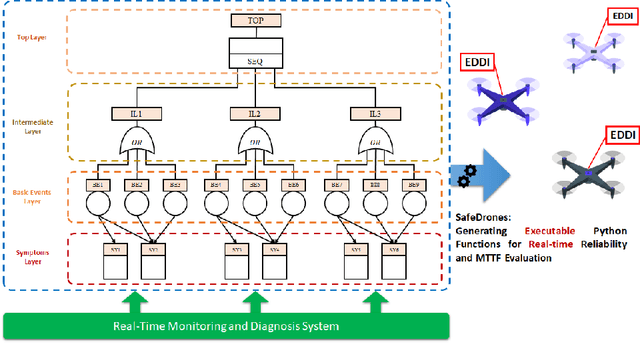

Abstract:The use of Unmanned Arial Vehicles (UAVs) offers many advantages across a variety of applications. However, safety assurance is a key barrier to widespread usage, especially given the unpredictable operational and environmental factors experienced by UAVs, which are hard to capture solely at design-time. This paper proposes a new reliability modeling approach called SafeDrones to help address this issue by enabling runtime reliability and risk assessment of UAVs. It is a prototype instantiation of the Executable Digital Dependable Identity (EDDI) concept, which aims to create a model-based solution for real-time, data-driven dependability assurance for multi-robot systems. By providing real-time reliability estimates, SafeDrones allows UAVs to update their missions accordingly in an adaptive manner.
Keep your Distance: Determining Sampling and Distance Thresholds in Machine Learning Monitoring
Jul 11, 2022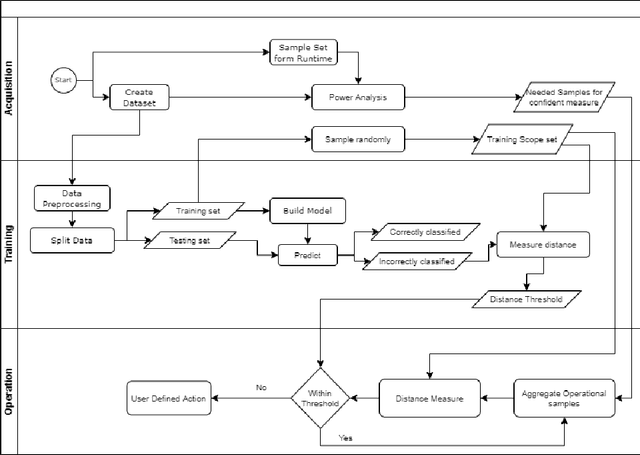

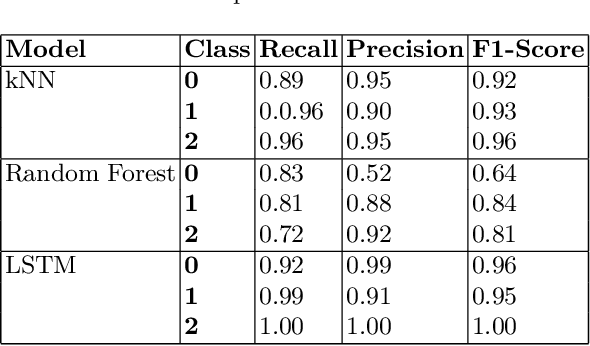
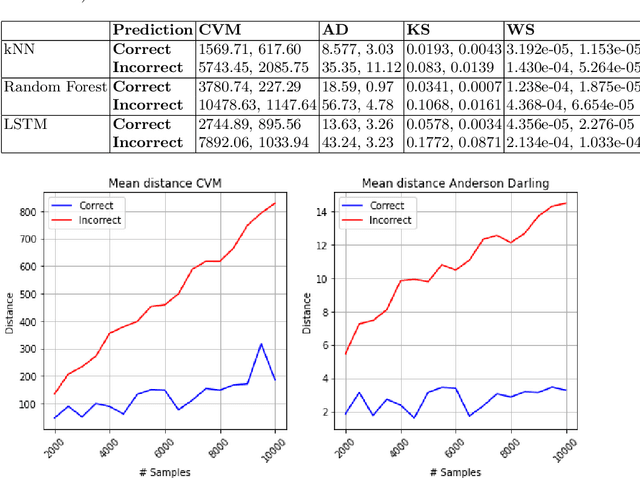
Abstract:Machine Learning~(ML) has provided promising results in recent years across different applications and domains. However, in many cases, qualities such as reliability or even safety need to be ensured. To this end, one important aspect is to determine whether or not ML components are deployed in situations that are appropriate for their application scope. For components whose environments are open and variable, for instance those found in autonomous vehicles, it is therefore important to monitor their operational situation to determine its distance from the ML components' trained scope. If that distance is deemed too great, the application may choose to consider the ML component outcome unreliable and switch to alternatives, e.g. using human operator input instead. SafeML is a model-agnostic approach for performing such monitoring, using distance measures based on statistical testing of the training and operational datasets. Limitations in setting SafeML up properly include the lack of a systematic approach for determining, for a given application, how many operational samples are needed to yield reliable distance information as well as to determine an appropriate distance threshold. In this work, we address these limitations by providing a practical approach and demonstrate its use in a well known traffic sign recognition problem, and on an example using the CARLA open-source automotive simulator.
StaDRe and StaDRo: Reliability and Robustness Estimation of ML-based Forecasting using Statistical Distance Measures
Jun 17, 2022


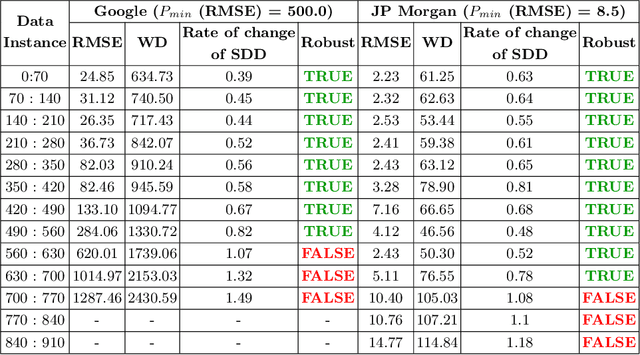
Abstract:Reliability estimation of Machine Learning (ML) models is becoming a crucial subject. This is particularly the case when such \mbox{models} are deployed in safety-critical applications, as the decisions based on model predictions can result in hazardous situations. In this regard, recent research has proposed methods to achieve safe, \mbox{dependable}, and reliable ML systems. One such method consists of detecting and analyzing distributional shift, and then measuring how such systems respond to these shifts. This was proposed in earlier work in SafeML. This work focuses on the use of SafeML for time series data, and on reliability and robustness estimation of ML-forecasting methods using statistical distance measures. To this end, distance measures based on the Empirical Cumulative Distribution Function (ECDF) proposed in SafeML are explored to measure Statistical-Distance Dissimilarity (SDD) across time series. We then propose SDD-based Reliability Estimate (StaDRe) and SDD-based Robustness (StaDRo) measures. With the help of a clustering technique, the similarity between the statistical properties of data seen during training and the forecasts is identified. The proposed method is capable of providing a link between dataset SDD and Key Performance Indicators (KPIs) of the ML models.
 Add to Chrome
Add to Chrome Add to Firefox
Add to Firefox Add to Edge
Add to Edge